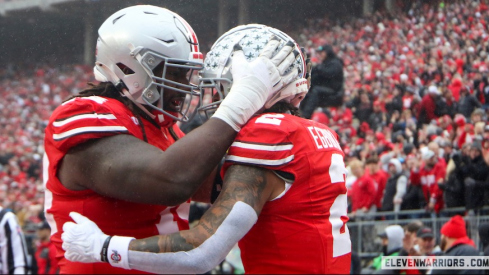 'Cause you can't, you won't, and you don't stop...
'Cause you can't, you won't, and you don't stop...With so much to talk about when it comes to the lack of growth and overall inconsistency of players 2-8 in Thad Matta's current rotation, it's easy to gloss over what kind of season Deshaun Thomas is having, almost taking it for granted.
The kid is flat out carrying a 15-4 basketball team that is probably the weakest squad since Matta's 2007-08 Buckeyes, led by Jamar Butler and Kosta Koufos, won the NIT Championship.
That in mind, I decided to take a look at the numbers to see how Thomas stacks up as a scorer this season, and to what degree he is carrying the offensive load, in comparison to other Ohio State leading scorers over the last 10 years.
First, let's check out Deshaun's offensive numbers this season versus other leading scorers in Columbus over the previous nine years.
| year | player | ppg | pps | total pts | fg% | 3fg% | FT% |
|---|---|---|---|---|---|---|---|
| 2003-04 | Tony Stockman | 13.6 | 1.09 | 393 | 38% | 36% | 79% |
| 2004-05 | Terence Dials | 15.9 | 1.48 | 509 | 57% | 0% | 62% |
| 2005-06 | Terence Dials | 15.3 | 1.41 | 488 | 56% | n/a | 66% |
| 2006-07 | Greg Oden | 15.7 | 1.63 | 501 | 62% | n/a | 63% |
| 2007-08 | Jamar Butler | 15.0 | 1.29 | 554 | 43% | 38% | 94% |
| 2008-09 | Evan Turner | 17.3 | 1.49 | 572 | 50% | 44% | 79% |
| 2009-10 | Evan Turner | 20.4 | 1.38 | 632 | 52% | 36% | 76% |
| 2010-11 | Jared Sullinger | 17.2 | 1.55 | 635 | 54% | 25% | 70% |
| 2011-12 | Jared Sullinger | 17.5 | 1.47 | 647 | 52% | 40% | 77% |
| 2012-13 | Deshaun Thomas | 20.0 | 1.29 | 380 | 47% | 42% | 81% |
The first thing that jumps off the page is just how incredibly bad the 2003-04 Buckeyes were. Stockman put up the worst points per game, points per shot and field goal percentage results of any Buckeye leading scorer over the last 10 years for a 14-16 outfit that would be Jim O'Brien's last but whatevs, this post is about Deshaun.
Looking at the list, Thomas is on track to become only the 2nd Buckeye over the last 10 years to average more than 20 points a night, standing at an even 20.0 after a sluggish performance yesterday in which he was held to his lowest output of the season, 11 points, on a shaky 4/13 from the floor.
To his credit, he waited until Ohio State played the worst team in the conference before stumbling. Further, he's performed anywhere from admirably to spectacularly in the five games Ohio State has played against legit opponents.
Back in November, at Duke, Thomas led the Buckeyes with 16 points in a 73-68 loss. It wasn't a dominant performance by any stretch but he did hit 6/14 shots in the face of constant double-teams while Aaron Craft and Lenzelle Smith Jr. were combining to shoot 7/25, taking zero pressure off Thomas.
 Guaranteed like Yoo-hoo...
Guaranteed like Yoo-hoo...Almost a month later, Ohio State welcomed Kansas to Columbus and Deshaun again scored 16, getting just 11 shots off, as the Jayhawks consistently doubled him without worry while his fellow starters shot a combined 8/34 from the field in an eight-point loss.
In Ohio State's only bad loss of the season, a thumping at the hands of the Illini, Thomas scored 24 of Ohio State's 55 points, playing 38 minutes. Only Craft joined him in double figures.
Two weeks ago against a Michigan squad that would've secured the number one ranking with a victory, Thomas logged 20 of Ohio State's 56 points in a three-point win that breathed some optimism into what had become a somewhat frustrating season. No other Buckeye reached double figures.
And most recently, Deshaun poured in 28 points, 18 in the 2nd half, in Ohio State's 59-56 loss at Michigan State just over a week ago. Thomas hit 10/20 from the floor and 6/11 from downtown, registering more field goals and three-pointers than all of his teamates combined. Combined. The rest of the squad shot 9/27, also scoring 28 points.
Overall, against the five legit opponents, Thomas is scoring 20.8 points per game and pouring in 35% of Ohio State's total points.
Back to the chart, his numbers really only stick out in already noted points per game department. His 1.29 points per shot metric is decent for a wing leading his team in scoring but falls well short of Evan Turner's scoring efficiency as both a sophomore and junior. Still, you can't argue with 20.0 points a night from a talented kid surrounded by teammates who are inconsistent when it comes to knocking down shots and decidedly inadequate at getting their own good looks.
His field goal percentage, while solid, is somewhat impacted (at least anecdotally) by those same scoring-challenged teammates as teams sag, double and slide over extra help-side defenders, making it all the more challenging for Thomas to get high-percentage looks. It's a testament to his stroke that he's connecting on 42% from downtown and 81% from the stripe.
So, having looked at Deshaun's scoring ability in comparison to fellow scoring leaders at Ohio State over the last 10 years, I wanted to see just what kind of offensive burden Thomas is saddled with in comparison to what his peers experienced over the years. To try to get a feel for it, I compiled the scoring stats for the top two scorers on each squad over the last decade and checked out just how many points Deshaun was scoring as a percentage of the overall team output.
| year | #1 scorer | ppg | % of team pts | #2 scorer | ppg | % of team pts | PPg diff |
|---|---|---|---|---|---|---|---|
| 2003-04 | T. Stockman | 13.6 | 20.2% | T. Dials | 10.4 | 16.1% | 3.2 |
| 2004-05 | T. Dials | 15.9 | 22.4% | T. Stockman | 12.0 | 15.1% | 3.9 |
| 2005-06 | T. Dials | 15.3 | 20.7% | J. Foster | 12.2 | 16.5% | 3.1 |
| 2006-07 | G. Oden | 15.7 | 17.2% | R. Lewis | 12.7 | 17.0% | 3.0 |
| 2007-08 | J. Butler | 15.0 | 21.7% | K. Koufos | 14.4 | 20.9% | 0.6 |
| 2008-09 | E. Turner | 17.3 | 25.9% | W. Buford | 11.3 | 16.9% | 6.0 |
| 2009-10 | E. Turner | 20.4 | 23.1% | W. Buford | 14.4 | 19.4% | 6.0 |
| 2010-11 | J. Sullinger | 17.2 | 22.2% | W. Buford | 14.4 | 18.2% | 2.8 |
| 2011-12 | J. Sullinger | 17.5 | 22.2% | D. Thomas | 15.9 | 21.2% | 1.6 |
| 2012-13 | D. Thomas | 20.0 | 27.4% | L. Smith | 10.2 | 14.0% | 9.8 |
When you pair up the two scorers from each season and examine the total percent of points scored by the main gun and also the separation between the leading scorer and his sidekick, you really start to see what Deshaun is doing, and what he's up against.
Through 19 games, Thomas is scoring 27.4% of the team's points, the most by any player over the last 10 years. The Villain scored 25.9% of his team's points in 2008-09 but he did have some capable help on a roster dotted with names like Buford and Diebler at least pitching in double figures on average. Other than Turner's 2009-10 campaign when he scored 23.1% of the total points, no Buckeye leading scorer has poured in more than 22.4% (Dials, '04-'05) of the team's total output.
 And everything I do is funky like Lee Dorsey
And everything I do is funky like Lee DorseyBottom line, 27.4% of the points is a ridiculous number on a decent team that ran through some cupcakes and also plays in the nation's toughest conference.
Even more eye-popping is how pronounced the gap is between Thomas and his sidekick versus what other star players have experienced. We've talked all season about the lack of a second scorer being the biggest threat to an early Dance exit so it's not new news, but when you look at the numbers from previous teams, you realize just what Thomas is up against.
At 10.2 points per game, Lenzelle Smith Jr. is the lowest scoring #2 option spanning the last 10 years. As such, he's also scoring the smallest percentage of his team's points compared to any other sidekick over that same span at 14%.
With Deshaun's impressive 20.0 points per game average bumped up against Smith's 10.2, you get a staggering 9.8 points per game differential, nearly four points higher than Turner dealt with in the 2008-09 and 2009-10 seasons. Digging further, Deshaun's other leading scorer peers had a partner hanging anywhere from just 1.6 to 3.9 points below their respective total.
Obviously, there are more than two players scoring points for a team but from a pressure and help standpoint, the lack of at least one other guy that can consistently chip in and make an opponent pay can have a favorable impact on how opposing coaches scheme to slow down the leading scorer.
Of course, these realities come with many pros and cons.
Having a big-time scorer is always a plus if you want to win games in the B1G and in March overall but without enough help, you run a high volume of risks such as the the player getting worn down, becoming increasingly frustrated, having an off night and potentially ending the season prematurely, or being forced into bad habits such as forcing shots or taking too many low percentage looks against constant double-teams.
At this point, the numbers paint a pretty compelling picture of just how much weight is on Deshaun's shoulders and how well he's handling the job.
The question is, can he keep it up, because more than halfway through the season, Ohio State is no closer to developing anyone to help carry the load.

